Mr. Chair and members of the committee, thank you for this opportunity to speak to you today. I would like to note that I am joining you from the traditional territory of the Algonquin people.
I am here this afternoon with Michèle Kingsley, Director General,Immigration Branch, and Alexandra Hiles, Director General, Domestic Network.
Immigration has been crucial in shaping Canada into the diverse and prosperous nation it is today. Through Canada's managed approach to migration, there are pathways for foreign nationals to study, work, and live in Canada, including access to citizenship.
Under the Constitution Act, 1867, immigration is a shared federal, provincial and territorial responsibility. Immigration, therefore, requires close and frequent engagement and collaboration with provincial and territorial counterparts.
Canada's approach to migration is intended to maximize Canada's economic and social well-being, while protecting the safety and security of Canadians. The department creates legal pathways for people to come to Canada on a temporary or permanent basis, and plans the number of new immigrants and the balance between permanent resident categories in advance.
However, immigration does much more than facilitating the movement of people. It brings people with skills, talent and social connections, thereby contributing to Canada's economic development and recovery, as well as enriching its diversity.
IRCC establishes annually the immigration levels plan. The latest plan released on February 14, 2022, describes the levels plan for 2022-24. It specifies the government's intention to welcome a significant number of new permanent residents: 431,645 in 2022; 447,055 in 2023; and 451,000 in 2024.
With the 2021-23 levels plan, IRCC started indicating the number of permanent resident admissions needed to meet the 4.4% francophone immigration target to be reached by 2023. This number is based on ranges, but specifically outside of the province of Quebec.
There are two major pathways to citizenship for immigrants wishing to stay or live in Canada: permanent residence, the basic facts of which are outlined in the levels plan I just described, and temporary residence, for temporary workers, international students and other visitors.
Today, I'll be focusing more on permanent residence, which concerns two main categories of immigrants: economic and non-economic. The latter are identified based on objectives associated with family reunification and social and humanitarian considerations.
Skilled workers are the first economic permanent residents. IRCC offers a range of economic programs, most of which are governed by the express entry electronic application processing system. That system facilitates the identification and selection of candidates with certain characteristics or basic human capital factors. For example, points are awarded to applicants who have a job offer based on their level of education, work experience or proficiency in one of the two official languages.
Then there is the applicant's nomination by a province or territory. Every province and territory has its own programs that may target international students residing in Canada, skilled workers or business people.
Lastly, the Canadian system provides refugee protection through two main programs: the refugee and humanitarian resettlement program, for persons seeking protection outside Canada, and the in‑Canada asylum program, for people filing refugee protection claims within Canada.
The visual diagram shared with you shows you the steps, starting from the submission of the request and its reception, to the decision-making process and the communication of the decision to the requester. In the latter step, the client receives the visa or residence permit.
The duration of the immigration process varies from one file to another, but it is understood that it can take from six months to two years for an immigrant of the economic class to settle permanently in Canada.
Now I'm going to discuss francophone immigration. It can be said that francophone immigration to Canada operates along two distinct lines: francophone immigration to Quebec and francophone immigration outside Quebec. Under the Canada-Québec Accord, reached in 1991, Quebec is the only province that publishes its immigration objectives and targets annually. However, Canada is required to establish the total number of permanent residents for the country as a whole, taking into consideration Quebec’s advice on the number of immigrants that it wishes to receive in all categories.
IRCC works with our Quebec government counterpart, the ministère de l'Immigration, de la Francisation et de l'Intégration, in a manner consistent with the two orders of government defined under the Canada-Québec Accord. For the purposes of my presentation, I would like to focus on francophone immigration outside Quebec. But, first of all, a few basic facts.
The government acknowledges that francophone immigration strengthens the social fabric of Canada and plays a key role in maintaining its bilingual character. Immigration is one of the factors that assists in maintaining francophones' demographic weight in Canada but is only one of many levers. Immigration cannot be considered the only solution. Francophone immigration assists francophone minority communities in developing economically, socially and culturally.
The particular focus of the government on francophone immigration dates back to 2003, which is when the 4.4% target for French-speaking immigrants outside Quebec was jointly established with the francophone community. More recently, and to streamline our approach, in 2019, the minister of IRCC announced the “Meeting Our Objectives: Francophone Immigration Strategy”, which reaffirmed the goal of achieving the target of 4.4% of French-speaking immigrants outside Quebec by 2023.
IRCC has put in place numerous activities to deepen the strategy, including additional points for strong French language skills of bilingual candidates introduced first under the express entry system in 2017 and then increased in 2020.



